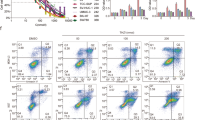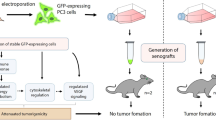Abstract
CD44 is a marker of cancer stem cell (CSC) in many types of tumors. Alternative splicing of its 20 exons generates various CD44 isoforms that have different tissue specific expression and functions, including the CD44 standard isoform (CD44s) encoded by the constant exons and the CD44 variant isoforms (CD44v) with variant exon insertions. Switching between the CD44v and CD44s isoforms plays pivotal roles in tumor progression. Here we reported a novel mechanism of CD44 alternative splicing induced by TGF-β1 and its connection to enhanced epithelial-to-mesenchymal transition (EMT) and stemness in human prostate cancer cells. TGF-β1 treatment increased the expression of CD44s and N-cadherin while decreased the expression of CD44v and E-cadherin in DU-145 prostate cancer cells. Other EMT markers and cancer stem cell markers were also upregulated after TGF-β1 treatment. RNAi knockdown of CD44 reversed the phenotype, which could be rescued by overexpressing CD44s but not CD44v, indicating the alternatively spliced isoform CD44s mediated the activity of TGF-β1 treatment. Mechanistically, TGF-β1 treatment induced the phosphorylation, poly-ubiquitination, and degradation of PCBP1, a well-characterized RNA binding protein known to regulate CD44 splicing. RNAi knockdown of PCBP1 was able to mimic TGF-β1 treatment to increase the expression of CD44s, as well as the EMT and cancer stem cell markers. In vitro and in vivo experiments were performed to show that CD44s promoted prostate cancer cell migration, invasion, and tumor initiation. Taken together, we defined a mechanism by which TGF-β1 induces CD44 alternative splicing and promotes prostate cancer progression.








Similar content being viewed by others
References
Thiery JP (2002) Epithelial-mesenchymal transitions in tumour progression. Nat Rev Cancer 2(6):442–454. https://doi.org/10.1038/nrc822
Mani SA, Guo W, Liao MJ, Eaton EN, Ayyanan A, Zhou AY, Brooks M, Reinhard F, Zhang CC, Shipitsin M, Campbell LL, Polyak K, Brisken C, Yang J, Weinberg RA (2008) The epithelial-mesenchymal transition generates cells with properties of stem cells. Cell 133(4):704–715. https://doi.org/10.1016/j.cell.2008.03.027
Xu H, Tian Y, Yuan X, Wu H, Liu Q, Pestell RG, Wu K (2015) The role of CD44 in epithelial-mesenchymal transition and cancer development. Onco Targets Ther 8:3783–3792. https://doi.org/10.2147/OTT.S95470
Chanmee T, Ontong P, Kimata K, Itano N (2015) Key roles of hyaluronan and its CD44 receptor in the stemness and survival of cancer stem cells. Front Oncol 5:180. https://doi.org/10.3389/fonc.2015.00180
Chen C, Zhao S, Karnad A, Freeman JW (2018) The biology and role of CD44 in cancer progression: therapeutic implications. J Hematol Oncol 11(1):64. https://doi.org/10.1186/s13045-018-0605-5
Jang BI, Li Y, Graham DY, Cen P (2011) The role of CD44 in the pathogenesis, diagnosis, and therapy of gastric cancer. Gut Liver 5(4):397–405. https://doi.org/10.5009/gnl.2011.5.4.397
Nagano O, Saya H (2004) Mechanism and biological significance of CD44 cleavage. Cancer Sci 95(12):930–935. https://doi.org/10.1111/j.1349-7006.2004.tb03179.x
Ponta H, Sherman L, Herrlich PA (2003) CD44: from adhesion molecules to signalling regulators. Nat Rev Mol Cell Biol 4(1):33–45. https://doi.org/10.1038/nrm1004
Brown RL, Reinke LM, Damerow MS, Perez D, Chodosh LA, Yang J, Cheng C (2011) CD44 splice isoform switching in human and mouse epithelium is essential for epithelial-mesenchymal transition and breast cancer progression. J Clin Invest 121(3):1064–1074. https://doi.org/10.1172/JCI44540
Biddle A, Gammon L, Fazil B, Mackenzie IC (2013) CD44 staining of cancer stem-like cells is influenced by down-regulation of CD44 variant isoforms and up-regulation of the standard CD44 isoform in the population of cells that have undergone epithelial-to-mesenchymal transition. PLoS One 8(2):e57314. https://doi.org/10.1371/journal.pone.0057314
Xu J, Lamouille S, Derynck R (2009) TGF-beta-induced epithelial to mesenchymal transition. Cell Res 19(2):156–172. https://doi.org/10.1038/cr.2009.5
Hao Y, Baker D, TenDijke P (2019) TGF-beta-Mediated epithelial-mesenchymal transition and cancer metastasis. Int J Mol Sci. https://doi.org/10.3390/ijms20112767
Chen Q, Cai ZK, Chen YB, Gu M, Zheng DC, Zhou J, Wang Z (2015) Poly r(C) binding protein-1 is central to maintenance of cancer stem cells in prostate cancer cells. Cell Physiol Biochem 35(3):1052–1061. https://doi.org/10.1159/000373931
Mima K, Hayashi H, Imai K, Kuroki H, Nakagawa S, Okabe H, Chikamoto A, Watanabe M, Beppu T, Baba H (2013) High CD44s expression is associated with the EMT expression profile and intrahepatic dissemination of hepatocellular carcinoma after local ablation therapy. J Hepatobiliary Pancreat Sci 20(4):429–434. https://doi.org/10.1007/s00534-012-0580-0
Bhattacharya R, Mitra T, Ray Chaudhuri S, Roy SS (2018) Mesenchymal splice isoform of CD44 (CD44s) promotes EMT/invasion and imparts stem-like properties to ovarian cancer cells. J Cell Biochem 119(4):3373–3383. https://doi.org/10.1002/jcb.26504
Ishii H, Saitoh M, Sakamoto K, Kondo T, Katoh R, Tanaka S, Motizuki M, Masuyama K, Miyazawa K (2014) Epithelial splicing regulatory proteins 1 (ESRP1) and 2 (ESRP2) suppress cancer cell motility via different mechanisms. J Biol Chem 289(40):27386–27399. https://doi.org/10.1074/jbc.M114.589432
Yae T, Tsuchihashi K, Ishimoto T, Motohara T, Yoshikawa M, Yoshida GJ, Wada T, Masuko T, Mogushi K, Tanaka H, Osawa T, Kanki Y, Minami T, Aburatani H, Ohmura M, Kubo A, Suematsu M, Takahashi K, Saya H, Nagano O (2012) Alternative splicing of CD44 mRNA by ESRP1 enhances lung colonization of metastatic cancer cell. Nat Commun 3:883. https://doi.org/10.1038/ncomms1892
Zhang P, Feng S, Liu G, Wang H, Fu A, Zhu H, Ren Q, Wang B, Xu X, Bai H, Dong C (2016) CD82 suppresses CD44 alternative splicing-dependent melanoma metastasis by mediating U2AF2 ubiquitination and degradation. Oncogene 35(38):5056–5069. https://doi.org/10.1038/onc.2016.67
Takeo K, Kawai T, Nishida K, Masuda K, Teshima-Kondo S, Tanahashi T, Rokutan K (2009) Oxidative stress-induced alternative splicing of transformer 2beta (SFRS10) and CD44 pre-mRNAs in gastric epithelial cells. Am J Physiol Cell Physiol 297(2):C330–338. https://doi.org/10.1152/ajpcell.00009.2009
Cheng C, Sharp PA (2006) Regulation of CD44 alternative splicing by SRm160 and its potential role in tumor cell invasion. Mol Cell Biol 26(1):362–370. https://doi.org/10.1128/MCB.26.1.362-370.2006
Tripathi V, Sixt KM, Gao S, Xu X, Huang J, Weigert R, Zhou M, Zhang YE (2016) Direct regulation of alternative splicing by SMAD3 through PCBP1 is essential to the tumor-promoting role of TGF-beta. Mol Cell 64(3):549–564. https://doi.org/10.1016/j.molcel.2016.09.013
Li M, Kao E, Gao X, Sandig H, Limmer K, Pavon-Eternod M, Jones TE, Landry S, Pan T, Weitzman MDJN (2012) Codon-usage-based inhibition of HIV protein synthesis by human schlafen 11. Nature 491(7422):125
Kluth M, Hesse J, Heinl A, Krohn A, Steurer S, Sirma H, Simon R, Mayer P-S, Schumacher U, Grupp KJMp (2013) Genomic deletion of MAP3K7 at 6q12-22 is associated with early PSA recurrence in prostate cancer and absence of TMPRSS2: ERG fusions. Mod Pathol 26(7):975
Arocho A, Chen B, Ladanyi M, Pan QJDMP (2006) Validation of the 2-DeltaDeltaCt calculation as an alternate method of data analysis for quantitative PCR of BCR-ABL P210 transcripts. Diagnostic Molecular Pathol 15(1):56–61
Tripathi V, Sixt KM, Gao S, Xu X, Huang J, Weigert R, ZhouZhang MYEJMc (2016) Direct regulation of alternative splicing by SMAD3 through PCBP1 is essential to the tumor-promoting role of TGF-β. Molecular Cell 64(3):549–564
Olsson E, Honeth G, Bendahl PO, Saal LH, Gruvberger-Saal S, Ringner M, Vallon-Christersson J, Jonsson G, Holm K, Lovgren K, Ferno M, Grabau D, Borg A, Hegardt C (2011) CD44 isoforms are heterogeneously expressed in breast cancer and correlate with tumor subtypes and cancer stem cell markers. BMC Cancer 11:418. https://doi.org/10.1186/1471-2407-11-418
Acknowledgements
The work was sponsored by the National Natural Science Foundation of China (Grant No. 81702498); Shanghai Jiao Tong university school of medicine multi-center clinical research project (DLY201809); General Scientific Research Project of Health and Family Planning Commission in Lianyungang City (201832).
Author information
Authors and Affiliations
Contributions
ZW, YBC and QC conceived the project, designed the experiments, and wrote the manuscript. QC, MG and ZKC performed and interpreted the majority of the experiments. HZ, SCS, CL and MZ performed experiments and analyzed the data. ZW and YBC supervised the project.
Corresponding authors
Ethics declarations
Conflict of interest
The authors declare that they have no conflict of interest.
Additional information
Publisher's Note
Springer Nature remains neutral with regard to jurisdictional claims in published maps and institutional affiliations.
Electronic supplementary material
Below is the link to the electronic supplementary material.
Rights and permissions
About this article
Cite this article
Chen, Q., Gu, M., Cai, Zk. et al. TGF-β1 promotes epithelial-to-mesenchymal transition and stemness of prostate cancer cells by inducing PCBP1 degradation and alternative splicing of CD44. Cell. Mol. Life Sci. 78, 949–962 (2021). https://doi.org/10.1007/s00018-020-03544-5
Received:
Revised:
Accepted:
Published:
Issue Date:
DOI: https://doi.org/10.1007/s00018-020-03544-5




